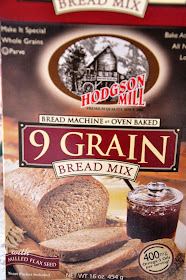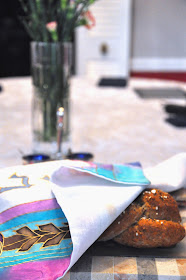Happy new year, everyone! 2011 was a big year. It was a history changing year around the world. It was the year I finally found some direction. And of course, it was the year I started this blog. I can't tell you how much the experience has exceeded all my expectations, and I just want to thank everyone who has stopped by, left me comment, or told me what you thought about The Inventive Vegetarian. It's been so encouraging and so rewarding, and I just can't wait to see what this new year brings.
Anyway, this is actually a post that I had written several months ago, but never got around to putting up. I decided to start the new year off with this one because challah is something that is very near and dear to my heart. It's one of the very few things I actually willingly, even eagerly, bake on a regular basis. Nothing makes a shabbat meal with friends or family like a warm loaf of homemade challah. What better way to start off a happy and healthy new year?
I definitely grew up in a water challah family. Even better, in a water challah family that sometimes makes its own. We’ve been following the same basic recipe for as long as I can remember, but with slight changes. Namely, the kind of flour we use. We’ve evolved from white flour to whole wheat flour to this fantastic nine grain flour mix that we love.
 |
| This stuff is SO good! |
So here’s the family (not so) secret recipe. I hope you like it as much as I do!
Challah
Makes 2 large loafs (or one loaf and 4-6 rolls)
Ingredients
11/2 cups warm water
1/2 cup sugar (though for Rosh Hashana my mom substitutes half of that with honey)
2 pkgs. dry yeast
5 cups flour, you can choose what kind (white, whole wheat, etc - I use 2 -3 cups 9 grain mix)*
1/2 cup oil
2 teaspoons salt
2 teaspoons salt
4 tablespoons water
2 tablespoons agave
Toppings of your choice (optional, though I recommend poppy or sesame seeds)
*The kind of flour you use will affect the consistency of the bread. For example, I when I make this bread with only unbleached, all purpose flour, the bread comes out pretty fluffy. Using the 9 grain mix, it comes out denser. Either way it's delicious.
Directions:
1. Proof the yeast. Pour 1/2 cup warm water into a measuring cup, add 1 tsp sugar and stir, add yeast to water and stir again. Allow to rest until yeast foams and rises to the top, about 10 mins. I’ve found that the more foam, the fluffier the bread.
2. Mix salt, sugar, and 3 cups of flour in a large bowl. Add the proofed yeast, oil and remaining water. Mix until it is a gooey mess, then add remaining flour, 1/2 cup at a time. When dough gets firmer, you can start kneading in the bowl, adding flour as needed until dough is smooth (and not sticky). Be careful not to add too much though. Knead for about 5 minutes, either slapping the dough into the mixing bowl or kneading it on a cutting board or clean counter top.
3. Form dough into a bowl place back in the bowl you mixed it in. Pour a little oil in your palm and spread it on the dough, to prevent it from forming a crust, and cover it loosely with a clean cloth
4. Let it rise till double in bulk. I generally like to make the dough one night, put it in the refrigerator, then bake it the next afternoon, giving it plenty of time to rise. If you want a quicker rise, put it in a warm enclosed space, like in an oven that was just heated to the lowest possible temp then turned off. If you’ve given your dough tons of time and it hasn’t doubled, but it’s still risen, that’s ok. The bread just might be denser (see note on flour above).
5. When you’re ready to braid your challah, punch down the dough (great activity for the little baker helpers), remove it from the bowl and let it rest for 5 minutes on a clean and flour-sprinkled surface.
6. Divide the dough into how many loafs you want. Now divide each of those parts into 3 or 4 equal sections, depending on the kind of braid you want (the one pictured here is a 4-stranded braid). Using your hands, roll out each piece of dough into a 10 -12 inch log, thicker in the middle and tapering at the ends.
7. Braid your challah! I like to start in the middle of the strands, work my way down, then go back for the top, pinching and tucking in both ends when I’m finished. I don’t know why I prefer this way, but I have a sneaking suspicion that my mother’s own habit has something to do with it.
7. Braid your challah! I like to start in the middle of the strands, work my way down, then go back for the top, pinching and tucking in both ends when I’m finished. I don’t know why I prefer this way, but I have a sneaking suspicion that my mother’s own habit has something to do with it.
 |
 |
 |
 |
If you want to make rolls, half the dough will make 4 good sized rolls. For each roll (not pictured here, sorry, but we only made half a recipe), I like to roll out a good sized strand of dough, then tie it in a knot. Then I tuck in the bottom tail so that you have a nice round roll with one tail sticking out the top.
8. Brush each loaf with the water-agave mixture. Sprinkle your favorite toppings onto the challah (pictured here – a mixture of poppy seeds, sesame seeds, and sea salt. Or, you can leave the toppings off, but still use the glaze. In fact, if you're doing that, I'd add a second layer of glaze 10 minutes into baking.
9. Bake the challah at 350F for 30 - 40 minutes, depending on the size (rolls will take less time), until they’re golden brown. To test if your challah is done, carefully pick it up (remember – it’s hot!) and knock on the bottom of it. If it sounds hollow, take those braided breads out of the oven!
Serve either warm or room temperature. Leftovers (if you have any, which I doubt you will) make really good toast and French toast.
Enjoy!








What a beautiful challah! And I love that it's full of multi-grains!
ReplyDeleteWhat a great looking bread! Thanks for sharing.
ReplyDeleteThis bread looks amazing, gorgeous photos! Happy New Year! :)
ReplyDeleteLooks delicious. I'm a big egg challah fan but may need to try a water version! I've been making a whole-wheat version and will now add some seeds too. Thanks for the recipe!
ReplyDeleteIt looks beautiful! Challah (well, a non-religious version) is offered at almost any German bakery as Zopf (braid), and my grandma always had one.
ReplyDeletewill definitely be trying this!!
ReplyDeletejust made this recipe for shabbat and it came out AMAZING!!! i tripled the recipe :-)
ReplyDeletep.s. you forgot to put the salt amount in the ingredient list
So glad you liked the recipe! And you're totally right about the salt....oops! It's fixed now. Thanks for pointing that out!
DeleteMay I suggest you also try a cornstarch-water wash? It's slicker and shinier than agave.
ReplyDeleteOoooh, great idea - thanks!
DeleteConfused about the flour comment? Do you use only 2-3 cups of the 9 grain mix? Or out of the 5 cups flour you use 2-3 and the rest white?
ReplyDeleteThe total amount of flour needed is 5 cups, regardless of flour type. I use a full box of the 9 grain mix, which only comes out to 2-3 cups of flour. I fill in the rest of the 5 cups with regular flour.
DeleteHope that helps!
Thank you!
Delete